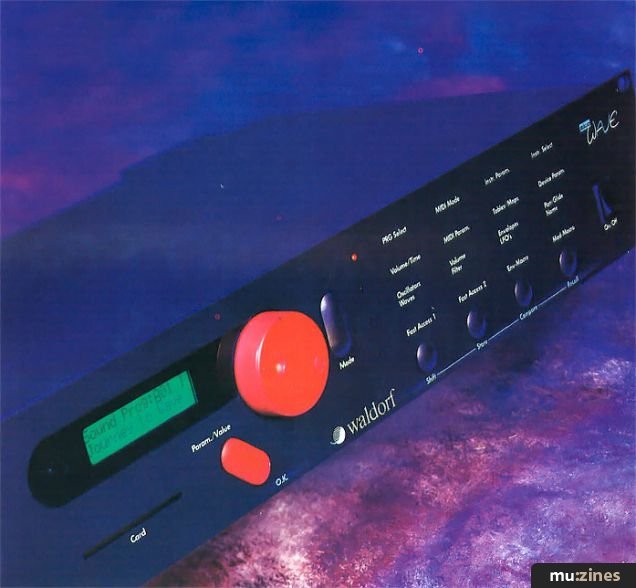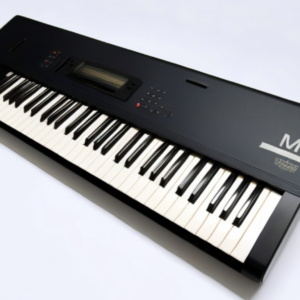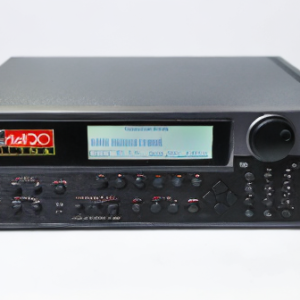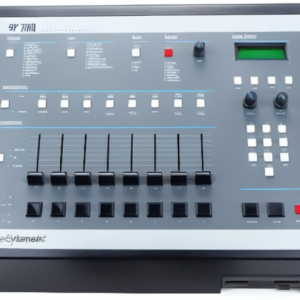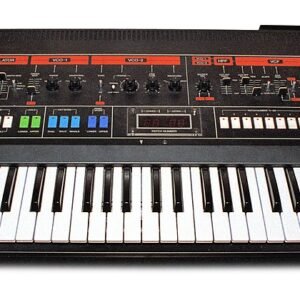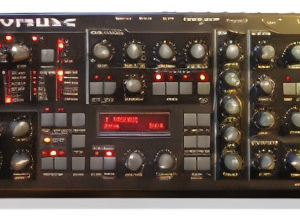Introduction and Background
The Waldorf Microwave, introduced in the late 1980s, marked a significant milestone in the realm of synthesizers. Developed by Wolfgang Palm, founder of Waldorf Music, the Microwave series was celebrated for its innovative wavetable synthesis technology, which offered musicians a new palette of sonic possibilities.
At the time of its release, the synthesizer market was dominated by analog and early digital synthesizers. However, the Waldorf Microwave stood out with its unique approach to sound generation. By utilizing wavetables – essentially digital representations of complex waveforms – the Microwave allowed for dynamic and evolving timbres that were not easily achievable with traditional synthesis methods.
Palm’s background in digital audio processing and his passion for pushing the boundaries of sound synthesis played a pivotal role in the development of the Microwave. His previous work in wavetable synthesis laid the foundation for what would become one of Waldorf’s most iconic synthesizer lines.
The Microwave series quickly gained recognition among electronic musicians, sound designers, and producers for its distinctive sound character and versatility. Its ability to morph between wavetables, modulate parameters in real-time, and create evolving textures set it apart in a rapidly evolving electronic music landscape.
As digital technology continued to advance, so did the capabilities of the Microwave series. Successive iterations introduced enhancements in sound quality, user interface design, and expanded synthesis capabilities, solidifying its reputation as a go-to instrument for musicians seeking cutting-edge sounds.
The Waldorf Microwave not only influenced the direction of synthesizer design but also left an indelible mark on electronic music production. Its legacy continues to inspire musicians and shape the sonic landscapes of contemporary music genres, reaffirming its status as an enduring icon in the world of synthesizers.
Design and Features
The Waldorf Microwave synthesizers were distinguished not only by their innovative sound capabilities but also by their sleek and functional design. Here, we delve into the design philosophy and standout features that made the Microwave series a staple in both studios and live setups.
1. Aesthetic Design: The Microwave series boasted a sleek and futuristic design aesthetic that was ahead of its time. Featuring a rugged metal chassis with ergonomic controls and a crisp LCD display, the synthesizers exuded a sense of sophistication and reliability.
2. User Interface: Waldorf prioritized user-friendliness in the design of the Microwave series. The front panel layout was intuitive and ergonomic, allowing for easy navigation of parameters and quick access to essential functions. The inclusion of dedicated knobs, buttons, and a comprehensive display made sound programming and editing a breeze.
3. Wavetable Synthesis: At the heart of the Microwave series was its groundbreaking wavetable synthesis engine. This technology allowed for the manipulation of complex waveforms in real-time, enabling users to create a vast array of evolving sounds and textures. The Microwave’s extensive wavetable library provided a rich sonic palette to explore, ranging from classic analog emulations to futuristic digital timbres.
4. Modulation and Control: One of the key strengths of the Microwave synthesizers was their extensive modulation capabilities. Users could easily assign modulation sources to a wide range of parameters, allowing for intricate sound shaping and dynamic expression. With multiple envelopes, LFOs, and modulation matrix routing options, the Microwave series offered unparalleled flexibility in sound design.
5. Connectivity: Waldorf ensured that the Microwave series was well-equipped for integration into various setups. Each synthesizer featured a comprehensive array of connectivity options, including MIDI In/Out/Thru, audio inputs and outputs, headphone output, and optional expansion slots for additional functionality. This versatility made the Microwave synthesizers ideal for both studio production and live performance environments.
6. Build Quality: Built to withstand the rigors of professional use, the Microwave synthesizers were renowned for their exceptional build quality and reliability. From the robust metal casing to the high-quality components used throughout, Waldorf spared no expense in ensuring that the synthesizers were built to last.
In summary, the Waldorf Microwave series combined cutting-edge technology, intuitive design, and exceptional build quality to deliver a synthesizer experience that was truly ahead of its time. Whether used for crafting intricate soundscapes in the studio or unleashing powerful textures on stage, the Microwave synthesizers left an indelible mark on electronic music production and continue to be revered by musicians and producers worldwide.
Sound Generation
The Waldorf Microwave series revolutionized sound generation with its pioneering wavetable synthesis technology, offering musicians unparalleled control over sonic exploration and expression. Here, we delve into the core principles of sound generation in the Microwave synthesizers and explore the creative possibilities they unlock.
1. Wavetable Synthesis: At the heart of the Waldorf Microwave series lies wavetable synthesis, a method of sound generation that utilizes digital wavetables to produce complex and evolving timbres. Unlike traditional subtractive synthesis, which relies on static waveforms, wavetable synthesis allows for seamless transitions between different waveforms, resulting in dynamic and morphing sounds.
2. Waveform Manipulation: One of the defining features of wavetable synthesis is its ability to manipulate individual waveforms in real-time. In the Microwave synthesizers, users can modulate various parameters such as wavetable position, wavetable selection, and wavetable blending to sculpt evolving textures and timbres. This level of control empowers musicians to create sounds that evolve and transform over time, adding depth and character to their compositions.
3. Oscillator Configuration: The Microwave synthesizers offer a diverse range of oscillator configurations, allowing users to experiment with different waveform combinations and harmonic structures. From classic analog-style waveforms to complex digital waveforms, the synthesizers provide a versatile palette for sound exploration. Additionally, features such as detuning, sync, and FM modulation further expand the sonic possibilities, enabling users to create rich and expressive sounds.
4. Filters and Effects: In addition to wavetable synthesis, the Microwave series features a range of filters and effects to shape and enhance the sound. Users can apply traditional low-pass, high-pass, and band-pass filters to sculpt the frequency content of their patches, adding warmth, depth, and character. Furthermore, built-in effects such as reverb, delay, chorus, and distortion provide further creative potential, allowing users to transform their sounds with spatialization, modulation, and saturation.
5. Envelopes and Modulation: The Microwave synthesizers offer extensive modulation options, allowing users to dynamically shape the evolution of their sounds. Multiple envelope generators and low-frequency oscillators (LFOs) can be assigned to various parameters, enabling expressive and animated performances. Whether creating evolving pads, rhythmic sequences, or intricate soundscapes, the modulation capabilities of the Microwave series facilitate endless experimentation and creativity.
In summary, the Waldorf Microwave series redefined sound generation with its innovative wavetable synthesis technology and comprehensive feature set. By combining wavetable manipulation, oscillator flexibility, filtering, effects, and modulation, the synthesizers empower musicians to push the boundaries of sonic exploration and create immersive and expressive music.
Notable Users and Influences
The Waldorf Microwave synthesizers have left an indelible mark on the world of electronic music, attracting a diverse array of musicians, producers, and sound designers who have embraced its unique sonic capabilities. Here, we explore some notable users and the influence of the Microwave series on electronic music production.
1. Ambient Pioneers: The ethereal and evolving sounds of the Waldorf Microwave found a natural home in the ambient music genre. Artists like Brian Eno, Klaus Schulze, and Robert Rich embraced the synthesizer’s ability to create immersive soundscapes and atmospheric textures, shaping the sonic landscape of ambient music and influencing generations of electronic musicians.
2. Experimental Electronica: The experimental nature of the Microwave series appealed to artists pushing the boundaries of electronic music. Pioneers of experimental electronica such as Autechre, Aphex Twin, and Squarepusher incorporated the synthesizer’s intricate sound design capabilities into their compositions, weaving complex rhythms, and abstract textures that challenged conventional notions of music.
3. Film and TV Scores: The versatility and cinematic quality of the Microwave synthesizers made them popular tools for film and television composers. From sci-fi soundtracks to atmospheric underscores, the synthesizers’ ability to evoke mood and emotion through sound played a significant role in shaping the sonic landscapes of film and TV scores. Notable composers such as Hans Zimmer, Vangelis, and Clint Mansell have utilized the Microwave series in their productions, contributing to its influence in the realm of visual media.
4. Electronic Music Producers: The Waldorf Microwave series has been embraced by electronic music producers across a wide range of genres, from techno and trance to IDM and beyond. Its dynamic sound-shaping capabilities, intuitive interface, and distinctive sonic character have made it a favorite among producers seeking to craft innovative and emotive electronic music. Artists like Richie Hawtin, Sasha, and The Chemical Brothers have all incorporated the Microwave synthesizers into their studio setups, contributing to its influence in contemporary electronic music.
5. Sound Design and Synthesis Education: Beyond its impact on music production, the Waldorf Microwave series has played a role in shaping the field of sound design and synthesis education. Its innovative wavetable synthesis engine and comprehensive feature set have made it a valuable tool for teaching synthesis concepts and techniques. Institutions and educators worldwide have integrated the Microwave synthesizers into their curriculum, inspiring the next generation of sound designers and electronic musicians.
In summary, the Waldorf Microwave synthesizers have made a profound impact on electronic music production, influencing artists across genres and disciplines. From ambient pioneers to experimental electronica artists, film composers, electronic music producers, and educators, the synthesizers’ versatile sound generation capabilities and distinctive sonic character have left an enduring legacy in the world of electronic music.
Impact and Legacy
The Waldorf Microwave synthesizers have left an indelible mark on the landscape of electronic music, shaping the way musicians approach sound design, composition, and performance. Here, we explore the impact and legacy of the Microwave series, tracing its influence across generations and genres.
1. Advancement of Sound Synthesis: The Waldorf Microwave series represented a significant advancement in sound synthesis technology, introducing wavetable synthesis to a broader audience and expanding the sonic possibilities available to musicians. Its innovative approach to sound generation inspired a new wave of experimentation and creativity, pushing the boundaries of what was thought possible with electronic instruments.
2. Evolution of Electronic Music: The unique sonic character of the Microwave synthesizers played a pivotal role in the evolution of electronic music genres such as ambient, experimental electronica, techno, and IDM. Artists embraced the synthesizer’s dynamic and evolving textures, incorporating them into their compositions to create immersive soundscapes, intricate rhythms, and abstract sonic landscapes. The influence of the Microwave series can be heard in countless electronic music productions, from underground releases to chart-topping hits.
3. Pioneering Sound Design: The Microwave synthesizers became synonymous with pioneering sound design, offering musicians and producers unprecedented control over the creation and manipulation of sounds. Its wavetable synthesis engine, modulation capabilities, and extensive feature set empowered users to craft unique and expressive patches that stood out in the mix. The synthesizer’s influence extended beyond music production, shaping the sound design landscape in film, TV, video games, and multimedia projects.
4. Cult Following and Collector’s Item: Over the years, the Waldorf Microwave synthesizers have garnered a devoted cult following among synthesizer enthusiasts, collectors, and aficionados. Their distinctive sound, sleek design, and historical significance have elevated them to coveted collector’s items, with vintage units fetching premium prices on the second-hand market. Despite advancements in technology, the allure of the Microwave series remains strong, fueling a thriving community of users who continue to explore its sonic potential.
5. Inspiration for Future Innovation: The legacy of the Waldorf Microwave series extends beyond its historical impact, serving as a source of inspiration for future innovation in sound synthesis and electronic instrument design. Its pioneering spirit and commitment to pushing the boundaries of sonic exploration continue to influence the development of new synthesizers, software instruments, and audio technologies. As electronic music evolves, the Microwave series remains a symbol of innovation, creativity, and sonic excellence.
In summary, the Waldorf Microwave synthesizers have left an enduring legacy in the world of electronic music, inspiring generations of musicians, producers, and sound designers with their groundbreaking technology, distinctive sound, and cultural significance. As they continue to shape the sonic landscape of electronic music, their impact and influence will be felt for years to come.
Collector's Value and Market Trends
The Waldorf Microwave synthesizers hold a special place in the hearts of synthesizer enthusiasts and collectors, commanding attention for their historical significance, distinctive sound, and innovative design. Here, we explore the collector’s value and market trends surrounding the Microwave series, shedding light on its enduring appeal and evolving market dynamics.
1. Vintage Rarity: As vintage synthesizers, the Waldorf Microwave series models have become increasingly rare and sought after by collectors. Produced in limited quantities during their initial release, these synthesizers are now prized for their unique sonic character and historical significance. Vintage units in good condition are highly coveted by collectors, driving up their market value and contributing to their status as collector’s items.
2. Historical Significance: The Waldorf Microwave synthesizers occupy a significant place in the history of electronic music technology, representing a milestone in the evolution of sound synthesis. Their introduction of wavetable synthesis to a broader audience, along with their pioneering features and capabilities, has cemented their legacy as iconic instruments that helped shape the sonic landscape of electronic music. This historical significance adds to their collector’s value and cultural cachet.
3. Market Demand: Despite the advancement of technology and the proliferation of digital synthesizers, the demand for Waldorf Microwave synthesizers remains strong among collectors and enthusiasts. Vintage units, particularly those in pristine condition with all original components and accessories, command premium prices on the second-hand market. The scarcity of these synthesizers, coupled with their unique sound and design, contributes to their sustained market demand.
4. Price Trends: Over the years, the prices of Waldorf Microwave synthesizers have experienced fluctuations in response to market demand, availability, and condition. Vintage units in excellent condition, accompanied by original packaging and documentation, often fetch higher prices than those with signs of wear or modification. Additionally, limited edition models or rare variants may command even higher premiums among collectors seeking unique pieces for their collections.
5. Future Outlook: As the synthesizer market continues to evolve, the collector’s value and market trends surrounding the Waldorf Microwave series are likely to fluctuate. While demand for vintage units may remain strong among collectors and enthusiasts, the emergence of digital emulations and software recreations may impact the perceived value of physical hardware. Nevertheless, the unique sound and historical significance of the Microwave synthesizers ensure their enduring appeal and relevance in the ever-changing landscape of electronic music technology.
In summary, the Waldorf Microwave synthesizers hold significant collector’s value and remain coveted items among synthesizer enthusiasts and collectors. Their historical significance, distinctive sound, and innovative design contribute to their enduring appeal, ensuring their place as iconic instruments in the annals of electronic music history.
Innovations and Contributions
The Waldorf Microwave synthesizers have made substantial innovations and contributions to the world of electronic music technology, pushing the boundaries of sound synthesis and shaping the sonic landscape in profound ways. Here, we delve into the key innovations and contributions of the Microwave series, highlighting their impact on music production, sound design, and technological advancement.
1. Wavetable Synthesis: Perhaps the most significant innovation introduced by the Waldorf Microwave synthesizers is wavetable synthesis. By utilizing wavetables – digital representations of complex waveforms – the Microwave series offered musicians unprecedented control over sound generation, allowing for dynamic and evolving timbres that were not easily achievable with traditional synthesis methods. This innovation opened up new creative possibilities and influenced the development of subsequent synthesizers and software instruments.
2. Real-Time Modulation and Control: The Microwave synthesizers provided extensive modulation capabilities, allowing users to dynamically shape and control sound parameters in real-time. With multiple envelopes, LFOs, and modulation matrix routing options, users could create intricate and expressive patches that evolved and transformed over time. This real-time modulation and control capability became a hallmark feature of the Microwave series, contributing to its versatility and appeal among musicians and sound designers.
3. Advanced Sound Design Tools: Waldorf’s commitment to sound design excellence is evident in the Microwave series, which offered a comprehensive suite of tools for crafting unique and expressive sounds. From oscillator configurations and wavetable manipulation to filters, effects, and modulation options, the synthesizers provided users with a rich palette of sonic possibilities to explore. These advanced sound design tools empowered musicians to push the boundaries of creativity and experimentation, leading to the creation of iconic sounds and textures that defined the era of electronic music production.
4. Influence on Future Instruments: The innovations introduced by the Waldorf Microwave synthesizers have had a lasting impact on the development of subsequent synthesizers and software instruments. Concepts such as wavetable synthesis, real-time modulation, and advanced sound design tools have been adopted and expanded upon by other manufacturers, influencing the design and functionality of a new generation of electronic instruments. The Microwave series paved the way for future innovation in sound synthesis and continues to inspire musicians, producers, and instrument designers to push the boundaries of what is possible with electronic music technology.
5. Cultural Significance: Beyond its technical innovations, the Waldorf Microwave series holds cultural significance as an iconic instrument that has shaped the sonic landscape of electronic music. Its distinctive sound, sleek design, and historical legacy have earned it a devoted following among musicians, collectors, and enthusiasts worldwide. The synthesizers’ contributions to electronic music production and sound design continue to be celebrated and revered, cementing their place in the annals of music history.
In summary, the Waldorf Microwave synthesizers have made significant innovations and contributions to the world of electronic music technology, from pioneering wavetable synthesis to advanced sound design tools and real-time modulation capabilities. Their influence extends far beyond their original release, shaping the sonic landscape and inspiring future generations of musicians, producers, and instrument designers to push the boundaries of creativity and innovation.
Community and Support
The Waldorf Microwave synthesizers have fostered a vibrant community of musicians, producers, enthusiasts, and experts who share a passion for innovative sound synthesis and electronic music technology. Here, we explore the community surrounding the Microwave series and the support network available to users, highlighting the collaborative spirit and resources that contribute to the synthesizers’ enduring appeal.
1. Online Forums and Communities: A plethora of online forums, discussion groups, and social media communities dedicated to the Waldorf Microwave synthesizers provide a platform for users to connect, share knowledge, and seek assistance. These forums serve as valuable resources for troubleshooting, patch sharing, technical advice, and general discussion, fostering a sense of camaraderie among users worldwide.
2. User Groups and Meetups: Local user groups and meetups offer opportunities for Microwave synthesizer enthusiasts to gather in person, exchange ideas, and collaborate on music projects. These gatherings provide a supportive environment for users to share tips and techniques, showcase their music, and network with like-minded individuals who share a passion for electronic music production.
3. Official Support Channels: Waldorf Music, the manufacturer of the Microwave synthesizers, provides official support channels, including customer service, technical support, and online resources such as user manuals, software updates, and firmware downloads. Users can reach out to Waldorf Music directly for assistance with troubleshooting, repairs, or inquiries about product features and compatibility.
4. Third-Party Resources and Tutorials: A wealth of third-party resources, including tutorial videos, online courses, and written guides, are available to help users unlock the full potential of their Microwave synthesizers. Experienced users and experts in sound synthesis often share their knowledge and expertise through educational content aimed at helping beginners and seasoned professionals alike master the intricacies of sound design and performance.
5. Collaborative Projects and Sound Libraries: The Microwave synthesizer community frequently collaborates on music projects, sound design initiatives, and collaborative albums, showcasing the diverse creative potential of the synthesizers. Users contribute patches, presets, samples, and compositions to shared repositories and libraries, allowing others to explore new sounds and techniques while fostering a spirit of collaboration and creativity.
In summary, the Waldorf Microwave synthesizers are supported by a thriving community of users, enthusiasts, and experts who contribute to their continued success and relevance in the world of electronic music. From online forums and user groups to official support channels and collaborative projects, the Microwave community offers a wealth of resources, support, and camaraderie to users seeking to explore the sonic possibilities of these iconic synthesizers.
Conclusion
The Waldorf Microwave synthesizers stand as enduring icons in the realm of electronic music technology, embodying a legacy of innovation, creativity, and sonic excellence. From their groundbreaking wavetable synthesis engine to their intuitive design, extensive feature set, and cultural significance, the Microwave series has left an indelible mark on electronic music production, sound design, and artistic expression.
Throughout their history, the Microwave synthesizers have pushed the boundaries of what is possible with sound synthesis, empowering musicians, producers, and sound designers to explore new sonic territories and express themselves in ways previously unimaginable. Their dynamic and evolving textures, versatile modulation capabilities, and rich sonic palette have inspired countless artists across genres and disciplines, shaping the sonic landscapes of ambient music, experimental electronica, film scores, and beyond.
Beyond their technical innovations, the Microwave synthesizers have fostered a vibrant community of users, enthusiasts, and experts who share a passion for electronic music and sound synthesis. Through online forums, user groups, collaborative projects, and educational resources, this community has cultivated a spirit of collaboration, creativity, and support, enriching the user experience and contributing to the synthesizers’ enduring appeal.
As we reflect on the legacy of the Waldorf Microwave synthesizers, we recognize not only their historical significance and cultural impact but also their ongoing relevance and influence in the ever-changing landscape of electronic music technology. Whether in the hands of seasoned professionals, aspiring musicians, or collectors seeking to preserve a piece of music history, the Microwave synthesizers continue to inspire, innovate, and captivate audiences around the world, ensuring their place as timeless classics in the annals of electronic music.
